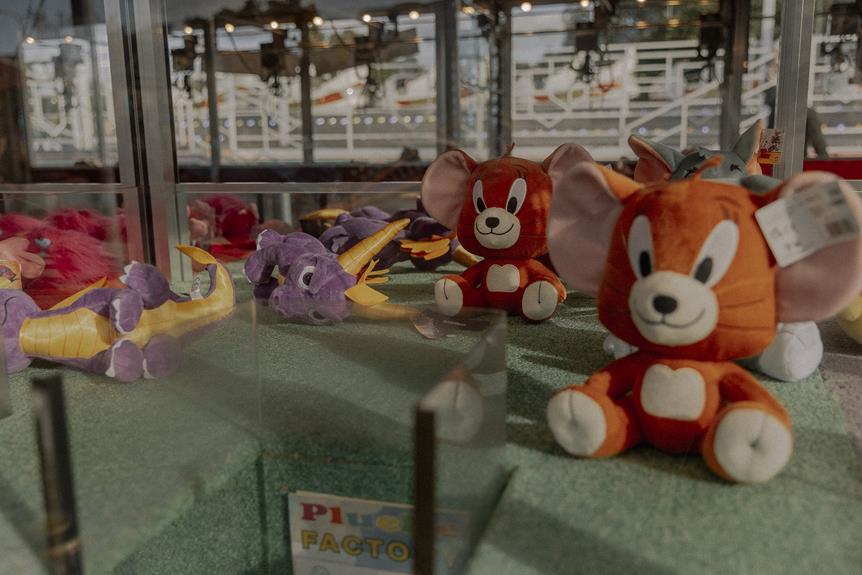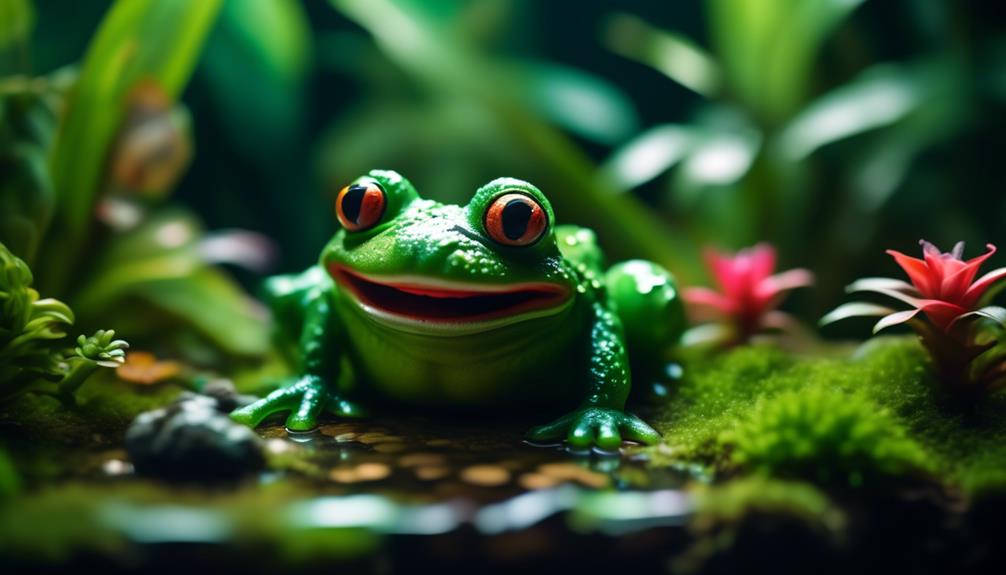Imagine yourself standing on the lush, tropical island of Komodo, surrounded by giants engaged in an epic battle for love. Welcome to the world of Komodo Dragons, where size and strength reign supreme.
In this article, we will delve into the intricacies of their mating battles, exploring the ritualistic behaviors, strategies, and tactics employed by these majestic creatures. Discover how defeat can have lasting consequences, and uncover the crucial role females play in selecting the victors of these fierce battles.
Key Takeaways
- Mating battles among Komodo dragons ensure reproductive success and maintain genetic diversity.
- Larger and stronger males have a higher chance of winning mating battles and passing on advantageous traits.
- Ritualistic behaviors and courtship displays are used by males to attract females and communicate readiness to mate.
- Female mate choice plays a crucial role in selecting the winners of mating battles and contributes to genetic diversity and the survival of the fittest.
The Nature of Komodo Dragon Mating Battles
You'll be amazed by the ferocity and intensity of Komodo dragon mating battles. These battles aren't just about dominance and territory, but also play a crucial role in ensuring reproductive success and maintaining genetic diversity within the population.
Male Komodo dragons engage in fierce combat, using their powerful jaws and sharp claws to overpower their opponents. The winner earns the right to mate with the female, ensuring his genes are passed on to the next generation.
This competition is vital for maintaining genetic diversity as it prevents inbreeding and promotes the mixing of different gene pools. The intense battles between these giants serve as a natural selection process, ensuring that only the strongest and most genetically diverse individuals get to pass on their genes, ultimately contributing to the survival and adaptability of the species.
Size and Strength: The Key Factors in Mating Success
To ensure mating success, the size and strength of male Komodo dragons play a crucial role in overpowering their opponents and securing the opportunity to reproduce. These powerful creatures engage in aggressive behavior during mating battles, where they use their immense size and strength to dominate their rivals.
The table below highlights the significance of size and strength in determining reproductive success among male Komodo dragons:
| Factors | Role in Mating Success |
|---|---|
| Size | Larger males have a higher chance of overpowering opponents. |
| Strength | Stronger males can inflict more damage on their rivals. |
As males engage in fierce battles, the dominant male emerges victorious and gains the right to mate with receptive females. This dominance hierarchy ensures that the strongest and fittest males have the greatest reproductive success, passing on their advantageous traits to the next generation.
With size and strength being key determinants of mating success, it is fascinating to explore the ritualistic behaviors, courtship, and mating displays exhibited by these giant reptiles.
[Transition sentence into the subsequent section about 'ritualistic behaviors: courtship and mating displays']
Ritualistic Behaviors: Courtship and Mating Displays
To witness the fascinating rituals of courtship and mating displays, you'll observe the intricate behaviors of male and female Komodo dragons as they navigate the complex world of reproduction.
Courtship in Komodo dragons begins with chemical cues. Males produce a specialized glandular secretion that contains pheromones, which are then released into the air to attract females. These chemical signals play a vital role in signaling readiness for mating.
Once a female is attracted, the male engages in various displays to court her. This includes head bobbing, tail wagging, and tongue flicking. These displays communicate the male's intentions and readiness to mate. Successful courtship displays can greatly increase the male's chances of reproductive success, as the female evaluates the male's fitness and ability to provide offspring with favorable genetic traits.
Strategies and Tactics: How Komodo Dragons Compete for Mates
To compete for mates, Komodo dragons employ a range of strategies and tactics.
One of the main methods is through physical displays of dominance, such as head bobbing and tail lashing, to intimidate rivals and attract potential mates.
In addition, these reptiles utilize chemical communication techniques, releasing pheromones from their cloacal glands to signal their availability to potential mates.
Lastly, competition for prime territory plays a crucial role, as Komodo dragons engage in intense battles to establish dominance over certain areas, which increases their chances of securing mates.
Physical Displays Dominance
Show off your strength and size to assert dominance and attract potential mates.
Komodo dragons, the largest lizards on Earth, engage in physical displays of dominance during courtship rituals. These displays involve a combination of territorial aggression and impressive posturing. Males use their powerful muscles to puff out their chests, raise their heads high, and open their mouths wide to showcase their intimidating size.
They also engage in fierce battles, intertwining their bodies and wrestling with each other to establish dominance. The winner of these battles gains the right to mate with the females in the area.
Chemical Communication Techniques
Use your sense of smell and taste to detect and analyze the chemical signals that Komodo dragons use in their competition for mates. These powerful reptiles employ various strategies to communicate their reproductive status and dominance to potential mates and rivals.
Here are some fascinating techniques they utilize:
- Pheromone Signaling: Komodo dragons produce pheromones, which are chemical substances released into the environment to attract mates. These pheromones can convey information about the dragon's health, genetic quality, and reproductive readiness.
- Scent Marking: Through scent marking, Komodo dragons leave chemical cues on their surroundings to establish territory and communicate their presence. They use specialized glands located on their cloaca to secrete a musky odor that can be detected by other dragons.
Competition for Prime Territory
Establish your dominance in the fierce competition for prime territory as Komodo dragons employ various strategies and tactics to compete for mates. Territorial disputes are common among these giants, as they fiercely defend their preferred areas.
Komodo dragons engage in resource competition, vying for the best hunting grounds and optimal nesting sites. They utilize their powerful sense of smell to detect the presence of other dragons in their territory. To mark their territory, these reptiles secrete a scent from glands located in their cloacal region.
Additionally, Komodo dragons engage in physical displays, such as head bobbing and tail whipping, to assert dominance and intimidate rivals. These battles for prime territory are crucial, as they determine access to valuable resources and potential mates, ensuring the survival and reproductive success of the fittest dragons.
Consequences of Defeat: The Aftermath of a Lost Battle
Feeling the sting of defeat, you'll be left contemplating the consequences of your lost battle with a Komodo dragon.
The aftermath of such a confrontation can be both emotionally traumatic and physically injurious. As you survey the battlefield, the reality of your defeat sinks in, accompanied by a wave of emotions. The emotional trauma of losing a battle with a formidable opponent like a Komodo dragon can leave lasting scars.
Along with the emotional toll, physical injuries are also a common consequence of defeat. From deep lacerations to broken bones, the injuries sustained during the battle can leave you vulnerable and in need of immediate medical attention. The consequences of defeat are significant and can't be taken lightly.
As you reflect on your loss, the role of females in selecting the winners of the mating battles becomes a crucial aspect to consider.
The Role of Females: Selecting the Winners of the Mating Battles
As a female Komodo dragon, you play a crucial role in the selection of mates. Your keen senses allow you to assess the physical condition and dominance of potential partners. By choosing the winners of the mating battles, you ensure that only the strongest and most fit males have the opportunity to pass on their genes, thereby improving the overall fitness of the species.
Your selective behavior plays a vital role in maintaining the genetic diversity and health of the Komodo dragon population.
Female Mate Choice
You should carefully observe the behaviors of female Komodo dragons in order to understand their role in selecting the winners of the mating battles. Female mate choice plays a crucial role in determining reproductive success in these giant reptiles. Here are some key aspects to consider:
- Size: Females tend to prefer larger males, as they're more likely to be successful in defending territories and winning battles.
- Odor: Females use their highly sensitive sense of smell to assess potential mates. They're attracted to males with a strong odor, which signals their health and genetic quality.
- Coloration: Brightly colored males are more attractive to females, as it indicates good health and vitality.
- Behavior: Females pay close attention to the courtship displays and combat skills of the males, selecting those with impressive displays and dominant behavior.
- Previous mating success: Females may be more likely to choose males who've previously successfully mated, as it indicates their ability to father offspring.
Understanding these factors is crucial in comprehending the dynamics of female mate choice in Komodo dragons. It sets the stage for the subsequent section, where we delve into the winners of the mating battles and their strategies for reproductive success.
Mating Battle Winners
You can't underestimate the importance of females in selecting the winners of the mating battles among Komodo dragons. While males engage in fierce combat to establish dominance and secure mating rights, it's ultimately the females who determine the ultimate victor.
The female Komodo dragon plays a vital role in shaping the outcome of these battles through her choice of mate. Females are known to favor males who display superior physical attributes and strategic mating battle strategies.
By selecting the winners, females indirectly influence the genes that are passed on to the next generation, which has significant evolutionary implications. This process helps ensure the survival of the fittest and contributes to the overall genetic diversity within the Komodo dragon population.
Understanding the role of females in selecting the winners of these battles provides valuable insights into the mating behavior and evolutionary dynamics of these fascinating creatures.
Frequently Asked Questions
How Long Do Komodo Dragon Mating Battles Typically Last?
On average, Komodo dragon mating battles last for a certain duration. Various factors influence the length of these battles. Understanding the average duration and the factors at play can provide insight into the fascinating world of Komodo dragon mating behavior.
Are There Any Physical Characteristics That Indicate a Komodo Dragon's Mating Potential?
To determine a Komodo dragon's mating potential, look for sexual dimorphism. Males are larger and have larger heads, while females are smaller and have a narrower head shape. Pheromones also play a role in indicating mating readiness.
Do Komodo Dragons Engage in Any Non-Aggressive Behaviors During Courtship?
During courtship, komodo dragons engage in various non-aggressive behaviors. These courtship rituals include head nodding, tongue flicking, and tail wagging. These actions serve to communicate reproductive interest and readiness for mating.
What Are Some Specific Tactics Used by Komodo Dragons to Gain an Advantage in Mating Battles?
To gain an advantage in mating battles, Komodo dragons employ various tactics. They use visual displays, such as head bobbing and tail wagging, to attract mates. Additionally, they engage in courtship rituals like circling and sniffing to establish dominance and allure potential partners.
How Do Komodo Dragons React to Defeat in a Mating Battle?
When defeated in a mating battle, Komodo dragons may display submissive behaviors such as retreating, avoiding confrontation, and lowering their heads. They may also try to find another potential mate to maintain reproductive success.
Conclusion
As you marvel at the majestic Komodo dragons engaged in their fierce mating battles, you can't help but be captivated by the intricate dance of size, strength, and strategy.
These prehistoric giants showcase their dominance through ritualistic displays, vying for the attention of the discerning females. Witnessing the consequences of defeat, you realize the high stakes involved in these battles.
Through their selective choices, the females play a crucial role in shaping the future of this extraordinary species.
The world of Komodo dragons is a captivating blend of power, beauty, and survival.


